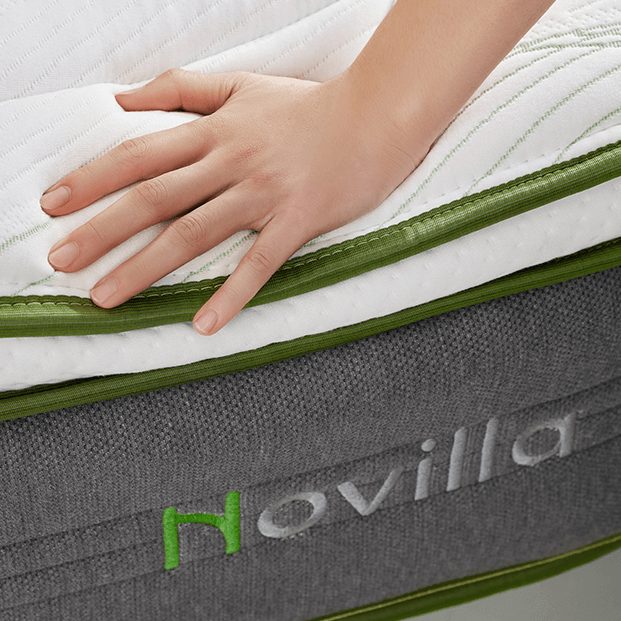No Products in the Cart
Admit it! washing our bedding is a chore that we can’t avoid. Neglecting this task can result in unsightly yellow stains and unpleasant odors that will make your bed less inviting. These stains are the result of sweat and oil that we naturally secrete during the night. With the heat that our bodies generate, it's no wonder that they appear so quickly. But don't worry, we're here to guide you through the process of washing your comforter.

The first step is to check the care label on your comforter to determine the type of filling and washing instructions. Most types can be washed in a washing machine but down requires gentler handling to protect the filling.
Pre-treat the stains on your comforter before you machine-washing it. Use a specialized stain remover and flip the comforter over if the stain has penetrated through to the other side. Make sure to let it sit for as long as possible before washing.
Washing a comforter is a time-consuming process and the comforter itself is large and bulky, taking up most of the available space in your machine. Plan to ensure that it won't disrupt your regular laundry day. We recommend having a spare comforter on hand in case your first one takes more than a day to dry. If you plan to air-dry your comforter outside, choose a sunny day to aid in the drying process.
It's also a good idea to check how the comforter is positioned in the washing machine. If it fills up the drum, that's great. But if your machine is overloaded, it's best to take it to a laundromat and use a more appropriately sized machine.
The type of detergent you choose will depend on the filling of your comforter and your personal preferences. For synthetic comforters with heavy stains, we recommend using a bio-liquid detergent for a thorough cleaning. However, if you have sensitive skin, stick with a non-bio detergent. If your comforter is filled with down, opt for a specialized down detergent.
Now that you have your detergent selected, it's time to wash your comforter. Set the washing machine to the appropriate temperature and spin cycle according to the care label instructions. Make sure to use enough rinse cycles to remove all traces of detergent. You can always add an extra rinse cycle for good measure. Generally, you'll want to use a gentle cycle, such as delicate or bedding.

1. First and foremost, make sure you have a duvet cover. This will make the cleaning process much easier, especially if you have a down or silk comforter.
2. Remove the duvet cover and turn it inside out. This will help to remove any dust or debris that may have accumulated in the corners.
3. Fill a large bucket or tub with hot water and add laundry detergent. Let the comforter soak for five minutes.
4. Transfer the comforter to a clean basin and continue to soak it, flipping it over from time to time to ensure that all areas are cleaned.
5. Drain the soapy water and refill the basin with clean water. Use your hands or a washboard to gently scrub the comforter, paying special attention to any stains or dirty areas.
6. Once you've finished scrubbing, drain the water and refill the basin with clean water. Rinse the comforter at least three times, until all soap residue is removed.
7. Gently wring out any excess water by hand or use a large towel to press out the water.
8. Hang the comforter outside on a sunny day to dry. Be sure to flip it over occasionally to ensure that both sides are completely dry.

Wool comforters are made of pure cotton flannel fabric, which is an important raw material in the textile industry. They are known for their elasticity, strong moisture absorption, and excellent warmth retention. Due to their high price, we recommend taking them to a dry cleaner to maintain their quality.
Down comforters don't need to be washed frequently. Cleaning them every two to three years is sufficient. You can either wash them with water or take them to a dry cleaner. When washing at home, use a small amount of neutral detergent and rinse thoroughly to avoid leaving any traces of detergent. After washing, place them in a well-ventilated area away from direct sunlight to dry completely.
When cleaning cotton comforters, you need to separate the inside and outside layers for washing. The outer layer can be washed in a washing machine, while the cotton filling inside needs to be sun-dried for three to four days to kill any mites or bacteria. If the cotton filling becomes lumpy due to long-term use, you can loosen it up to make it more fluffy, which will provide better warmth during winter.
Silk comforters are made up of three layers: silk, inner cover, and outer cover. The silk and inner cover are combined to form the comforter core, which cannot be washed with water or dry cleaned. Only the outer cover needs to be cleaned regularly.
If you accidentally stain the silk core, use a specialized detergent to clean the area and air dry it in a well-ventilated area away from direct sunlight. If the core is heavily stained, it's best to take it to a professional cleaner.
Fiberfill comforters can be washed directly in a washing machine or by hand with warm water and mild detergent. Avoid using laundry powder and keep the washing time short (around 30 minutes). You can spin-dry them in a washing machine, but avoid dry cleaning. After washing, make sure to air-dry them completely in a well-ventilated area to prevent mold and mildew from forming during humid summers.
In conclusion, different types of comforters require different cleaning methods. By following these guidelines, you can keep your comforters clean and cozy for many winters to come!

1.For cotton comforters, it's best to use a dryer on a low heat setting with a few dryer balls to help prevent clumping. Be sure to pause the cycle every 20 minutes to fluff the comforter and check for dryness. If the comforter is still damp, hang it up to air dry until it's completely dry.
If you don't have a dryer, air drying is also an option. Hang the comforter outside or on an indoor drying rack, and be sure to fluff it every few hours to prevent clumping. Make sure the area is well-ventilated to aid in the drying process.
2.For down comforters, hand washing in cold water is the best option to avoid damaging the delicate feathers. Avoid using dry cleaning chemicals, as they can strip the feathers of their insulating properties.
3.Silk comforters should also be air dried in a well-ventilated area, as washing or drying them in high heat can damage the silk fibers.
4.Synthetic comforters can generally be washed and dried in a machine, but be sure to use a gentle cycle and low heat setting to avoid damage.
In summary, always check the care label before washing or drying your comforter, and use the appropriate method for the material. With these tips, your comforter will be fresh and cozy in no time!

That depends on your need, the unexpected spill or someone in your household is sick, it’s best to wash your comforter as soon as possible. Generally speaking, you should wash your comforter every four months, which is also similar that we recommend the frequency to clean your pillow. However, it's important to note that you may need to wash your bedding more frequently depending on how hot you get at night and how much you sweat. So, it's essential to regularly check your bedding and adjust your cleaning schedule accordingly.
In summary, there's no one-size-fits-all answer to how often you should wash your bedding. But by paying attention to your needs and keeping a regular cleaning schedule, you can ensure that your bedding remains fresh and clean, allowing you to enjoy a comfortable and restful night's sleep.


